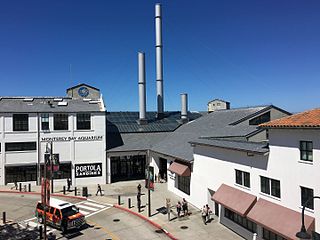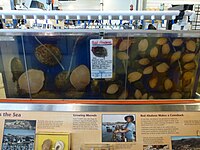
Frank Owen Gehry is a Canadian-born American architect and designer. A number of his buildings, including his private residence in Santa Monica, California, have become world-renowned attractions.

Monterey Bay Aquarium is a nonprofit public aquarium in Monterey, California. Known for its regional focus on the marine habitats of Monterey Bay, it was the first to exhibit a living kelp forest when it opened in October 1984. Its biologists have pioneered the animal husbandry of jellyfish and it was the first to successfully care for and display a great white shark. The organization's research and conservation efforts also focus on sea otters, various birds, and tunas. Seafood Watch, a sustainable seafood advisory list published by the aquarium beginning in 1999, has influenced the discussion surrounding sustainable seafood. The aquarium is the home of the current oldest living sea otter, Rosa, and the birthplace of Otter 841.

San Pedro is a neighborhood located within the South Bay and Harbor region of the City of Los Angeles, California, United States. Formerly a separate city, it consolidated with Los Angeles in 1909. The Port of Los Angeles, a major international seaport, is partially located within San Pedro. The district has grown from being dominated by the fishing industry, to a working-class community within the city of Los Angeles, to an increasingly dense and diverse community.

Omaha's Henry Doorly Zoo and Aquarium is a zoo in Omaha, Nebraska. It is accredited by the Association of Zoos and Aquariums and a member of the World Association of Zoos and Aquariums. In August 2014, TripAdvisor rated it the "world's best zoo", ahead of the San Diego Zoo and Loro Parque, based on an algorithmic assimilation of millions of reviews for 275 major zoos worldwide.

The Vancouver Aquarium is a public aquarium located in Stanley Park in Vancouver, British Columbia, Canada. In addition to being a major tourist attraction for Vancouver, the aquarium is a centre for marine research, ocean literacy education, climate activism, conservation and marine animal rehabilitation.

The California Science Center is a state agency and museum located in Exposition Park, Los Angeles, next to the Natural History Museum of Los Angeles County and the University of Southern California. Billed as the West Coast's largest hands-on science center, the California Science Center is a public-private partnership between the State of California and the California Science Center Foundation. The California Natural Resources Agency oversees the California Science Center and the California African American Museum. Founded in 1951 as the "California Museum of Science and Industry", the Museum was remodeled and renamed in 1998 as the "California Science Center". The California Science Center hosts the California State Science Fair annually.

Mote Marine Laboratory is an independent, nonprofit, marine research organization based on City Island in Sarasota, Florida, with additional campuses in eastern Sarasota County, Boca Grande, Florida, and the Florida Keys. Founded in 1955 by Eugenie Clark in Placida, Florida, it was known as the Cape Haze Marine Laboratory until 1967. The laboratory aims to advance marine science and education, supporting conservation and sustainable use of marine resources. A public aquarium and associated education program interpret its research for the public.

The Maritime Aquarium at Norwalk is an aquarium located in the South Norwalk section of Norwalk, Connecticut.

The New World Center is a concert hall in the South Beach section of Miami Beach, Florida, designed by Frank Gehry. It is the home of the New World Symphony, with a capacity of 756 seats. It opened in January 2011.

The Florida Aquarium is a 501(c)(3) non-profit organization, publicly operated institution located in downtown Tampa, Florida, United States. It is a large scale, 250,000-square-foot (23,000 m2) aquarium and is accredited by the Association of Zoos and Aquariums. This means they are a leader in conservation and education, supporting programs for wildlife and having a strong educational component in the forms of summer camps, school trips, etc. The facility is home to more than 7,000 aquatic plants and animals from Florida and all over the world. The facility is located in the Channel District of Downtown Tampa. The Florida Aquarium opened in March 1995 as a privately funded entity and became a public-private partnership when the city of Tampa assumed responsibility for its debt in 1999. On April 18, 2012, the AIA's Florida Chapter placed the Florida Aquarium on its list of Florida Architecture: 100 Years. 100 Places.

Birch Aquarium is an aquarium and the public outreach center for Scripps Institution of Oceanography at the University of California, San Diego. Accredited by the Association of Zoos and Aquariums, Birch Aquarium has an annual attendance of more than 439,000, including more than 40,000 school children, and features more than 3,000 animals representing 380 species. The hilltop site provides views of the Scripps Institution of Oceanography campus and the North Pacific Ocean. The mission of the aquarium reads: "As the public outreach center for Scripps Institution of Oceanography at UC San Diego, Birch Aquarium features the groundbreaking work of Scripps Oceanography and UC San Diego scientists through innovative exhibits and events. More than just an aquarium, Birch Aquarium offers hands-on learning opportunities and climate-based programming to 40,000-plus K-12 students each year on site, in schools and in the field.".

Shark Reef Aquarium is a public aquarium on the Las Vegas Strip in Paradise, Nevada. It is located at and owned by the Mandalay Bay resort. The attraction opened on June 20, 2000. Its main tank is 1,300,000 US gallons (4,900,000 L), one of the largest in North America. The facility is 105,000 sq ft (9,800 m2), and displays numerous species of sharks, rays, fish, reptiles, and marine invertebrates. It also features a shark tunnel. The reef was developed in consultation with the Vancouver Aquarium.

The Virginia Aquarium & Marine Science Center, formerly known as the Virginia Marine Science Museum, is an aquarium and marine science museum located in Virginia Beach, Virginia, just south of Rudee Inlet. The exhibits at the museum are contained in over 800,000 US gallons (3,028,000 L) of fresh and saltwater displays.

Cabrillo Beach is a historic public beach located in San Pedro, Los Angeles, California. It is named after Juan Rodríguez Cabrillo, a Spanish explorer who was the first to sail up the California coast. Cabrillo has two separate beach areas.

The Cox Science Center and Aquarium, formerly the South Florida Science Center and Aquarium, is a science museum located in West Palm Beach, Florida. Founded in 1959, the goal of the organization is to open every mind to science through the strategic programming of interactive exhibits and engaging community-based camps and events. The Cox Center has expanded since its creation and now houses over 50 hands-on exhibits, a planetarium, a 3000 square foot aquarium, a miniature golf course, and a large exhibit space that displays a temporary travelling exhibit. The Cox Center is a member of the Association of Science-Technology Centers program, which offers a membership that is redeemable at other ASTC science and technology centers around the world. The Cox Center occupies Dreher Park alongside the Palm Beach Zoo and offers deals for entrance into both facilities.
Children's Institute Inc. (CII) is a nonprofit organization that provides services to children and families healing from the effects of family and community violence within Los Angeles. Founded in 1906 by Minnie Barton, Los Angeles's first female probation officer, the organization was first designed to help troubled young women who found themselves adrift in Los Angeles." The organization has since expanded its services to at-risk youth in Los Angeles who are affected by child abuse, neglect domestic and gang violence as well as poverty. CII is a multi-service organization that combines evidence-based clinical services, youth development programs and family support services designed to address the whole child and entire family. The organization provides various forms of trauma support—including therapy, intervention services, parenting workshops, early childcare programs and other support services offered in English, Spanish and Korean.
John Main Olguin was an American aquarium official who served as the museum director of the Cabrillo Marine Museum, which has since been renamed the Cabrillo Marine Aquarium, from 1949 until 1987, when he became director emeritus. Olguin has been called the "father of recreational whale watching", as he was the founder of the Cabrillo Whalewatch program and a founding member of the American Cetacean Society.

The Adventure Aquarium, formerly the Thomas H. Kean New Jersey State Aquarium, is a for-profit educational entertainment attraction operated in Camden, New Jersey on the Delaware River Camden Waterfront by Herschend Family Entertainment. Originally opened in 1992, it re-opened in its current form on May 25, 2005 featuring about 8,000 animals living in varied forms of semi-aquatic, freshwater, and marine habitats. The facility has a total tank volume of over 2 million US gallons (7,600,000 L), and public floor space of 200,000 square feet (19,000 m2).
























